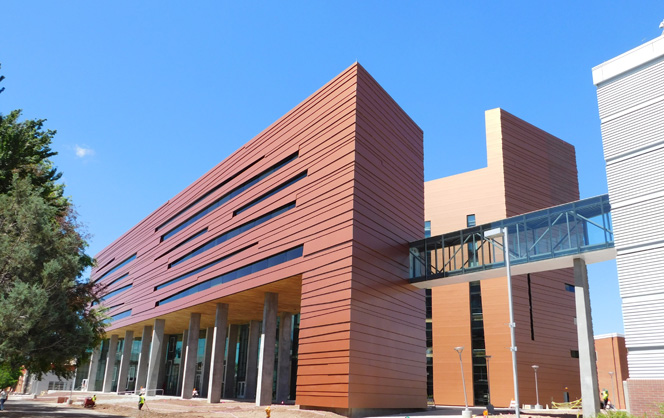Questions abound about the future of science education, but there is no need to look any further than the new Science and Health Building on the Northern Arizona University campus to appreciate the university’s commitment to doing something about it.
The impressive five-story structure serves as a focal point that symbolizes NAU’s rise to scientific and research prominence. And once inside the expansive atrium with angular sight lines, even the casual visitor can see right away that this is not just another building, but a confluence of knowledge and curiosity—a place to experience growth.
“The Science and Health Building is a spectacular addition to the North Campus Science Quad,” said Paul W. Jagodzinski, dean of the College of Engineering, Forestry and Natural Sciences. “The students will be learning in a wonderful array of classrooms and laboratories and researchers will have access to modern facilities that were so desperately needed.”
The spacious building hosts four floors devoted to general chemistry labs and lecture halls, offices, interactive spaces and research labs. Even the basement will host labs and connect the building with the nearby Science Lab Building through a concrete tunnel for the safe transport of chemicals. The Center for Science Teaching and Learning occupies most of the fifth floor.
 |
While the exterior draws attention with a distinctive array of uneven horizontal lines and sheer size—the building rises 129 feet on north campus—it’s the interior that manages to invite through an open feel while at the same time providing ample teaching and learning space for up to 1,900 people. Along hallways benefitting from natural lighting are 54 faculty offices, nine interaction rooms and 10 interaction spaces, 18 research labs and eight instructional labs, five classrooms and three lectures halls with a total capacity of 440 seats.
Most of the building’s footprint will transform the environment in which chemistry is taught at NAU.
According to Edgar Civitello, chair of the Department of Chemistry and Biochemistry, “It is arguably the most complex building on campus, and represents the state of the art in both form and function.”
Civitello said the ability to operate six teaching labs concurrently represents a 100 percent increase in capacity, and that ultra-modern research labs represent all major areas of chemistry: physical, organic, analytical, inorganic and biochemistry.
“We estimate that over 10 percent of NAU’s student population will make their way through this building each semester,” Civitello said. “The only drawback is fighting the urge to stare out the windows at the spectacular views.”
Paul Dufek, the NAU project manager who served as liaison between the university, the design team and the general contractor, emphasized safety, security and aesthetics as features that received intense attention throughout the design and construction. Even the layout of utilities—“one of the most difficult challenges about a chemistry building,” he said—were scrutinized with 3D computer modeling to ensure quick access.
Now that much of the space is already occupied, Dufek is coordinating the whittling down of a 3,000-item punch list. “It’s a great feeling that we’re in the building,” he said. “The next month will go fast as we get it ready for the students to return.”
Joëlle Clark said the Center for Science Teaching and Learning, one of the first occupants, has already experienced the building’s many benefits. Clark is the center’s associate director for professional development, a function that peaks in the summer.
“Being part of the group that has moved into this new building is a recognition of the value of STEM education to the university,” Clark said. “We feel like the updated classrooms and interaction spaces are an invitation to students to collaborate with each other in their learning and be fantastic STEM teachers.”
The center now has a large materials management area to store the copious supplies needed to operate pre-service teacher training, two master’s degree programs and a thriving professional development program for K-12 teachers. Dedicated lab space and classrooms allow the center to model lessons, experiments and demonstrations central to its work with science teachers. Additionally, a large distance education classroom outfitted with state-of-the-art video conferencing technology will make graduate program courses available to teachers statewide and beyond.




